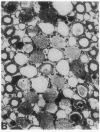Abstract
Human radiocontrast nephrotoxicity is predicted by the presence of multiple risk factors, often associated with compromised renal circulation. To produce a simple model of radiocontrast nephropathy, rats were pretreated with indomethacin and N omega-nitro-L-arginine methyl ester (L-NAME, to inhibit nitric oxide synthesis) before the administration of iothalamate. Acute renal failure consistently developed, with a decline in creatinine clearance from 1.05 +/- 0.10 to 0.27 +/- 0.05 ml/min (P < 0.001) associated with selective necrosis of 49 +/- 9% of medullary thick ascending limbs. Hemodynamic studies using laser-Doppler probes revealed that when injected alone, iothalamate increased outer medullary blood flow to 196 +/- 25% of baseline (P < 0.001). Pretreatment by L-NAME or indomethacin both reduced basal medullary blood flow and transformed the medullary vasodilator response to radiocontrast into vasoconstriction, with a prolonged reduction of medullary blood flow to less then half of baseline. Combined administration of indomethacin, L-NAME, and iothalamate lowered medullary blood flow to 12 +/- 4% of baseline. We conclude that prostanoids and nitric oxide have an important protective role in the renal response to radiocontrast material. Reduced synthesis of these vasoactive substances in renal/vascular diseases may predispose patients to radiocontrast nephropathy.
Full text
PDF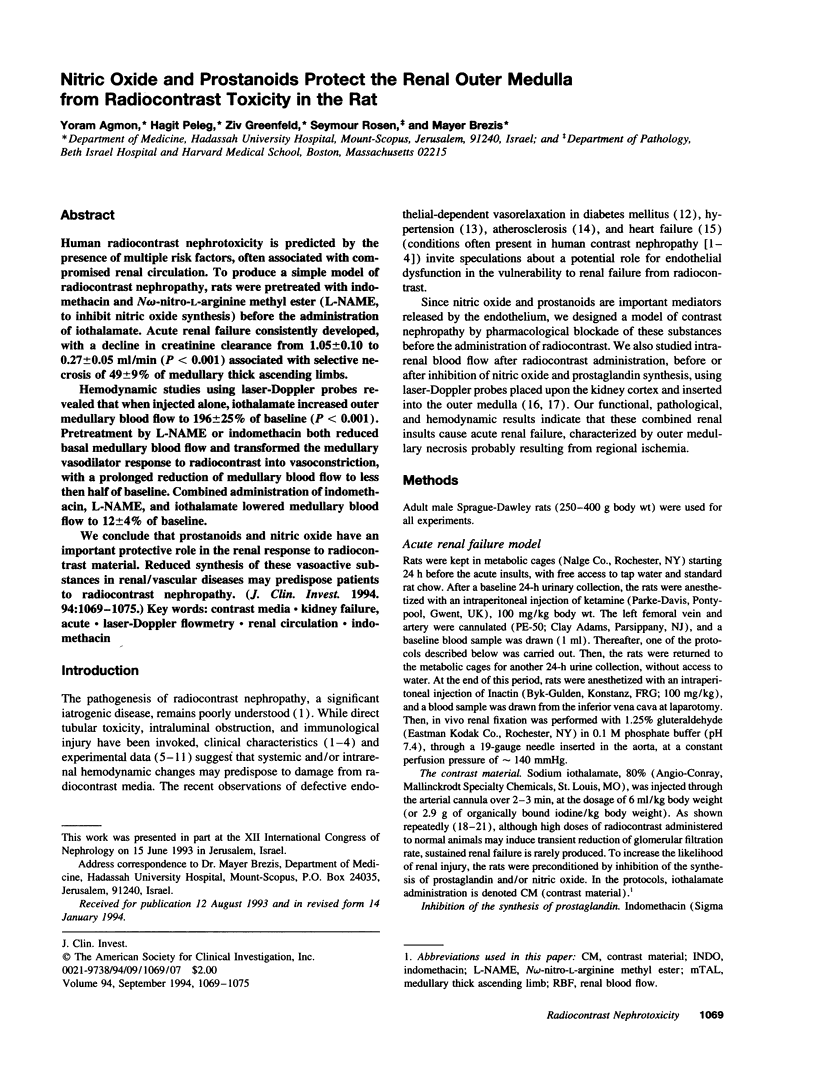
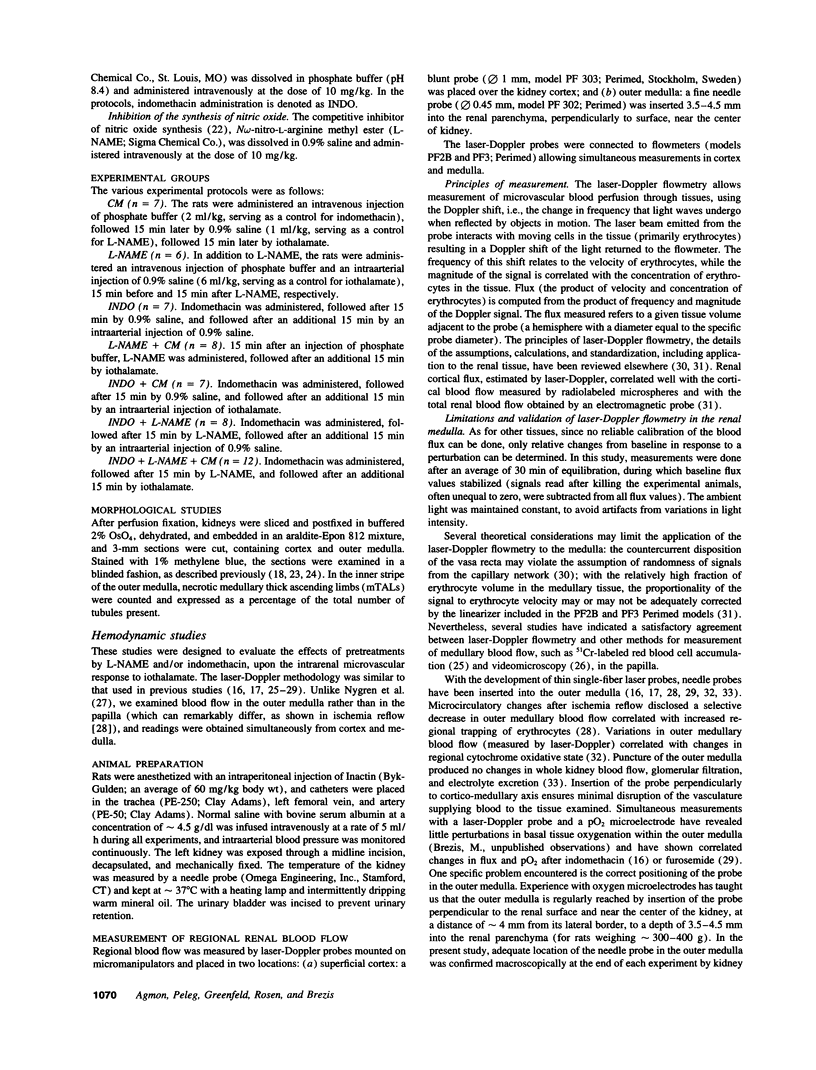
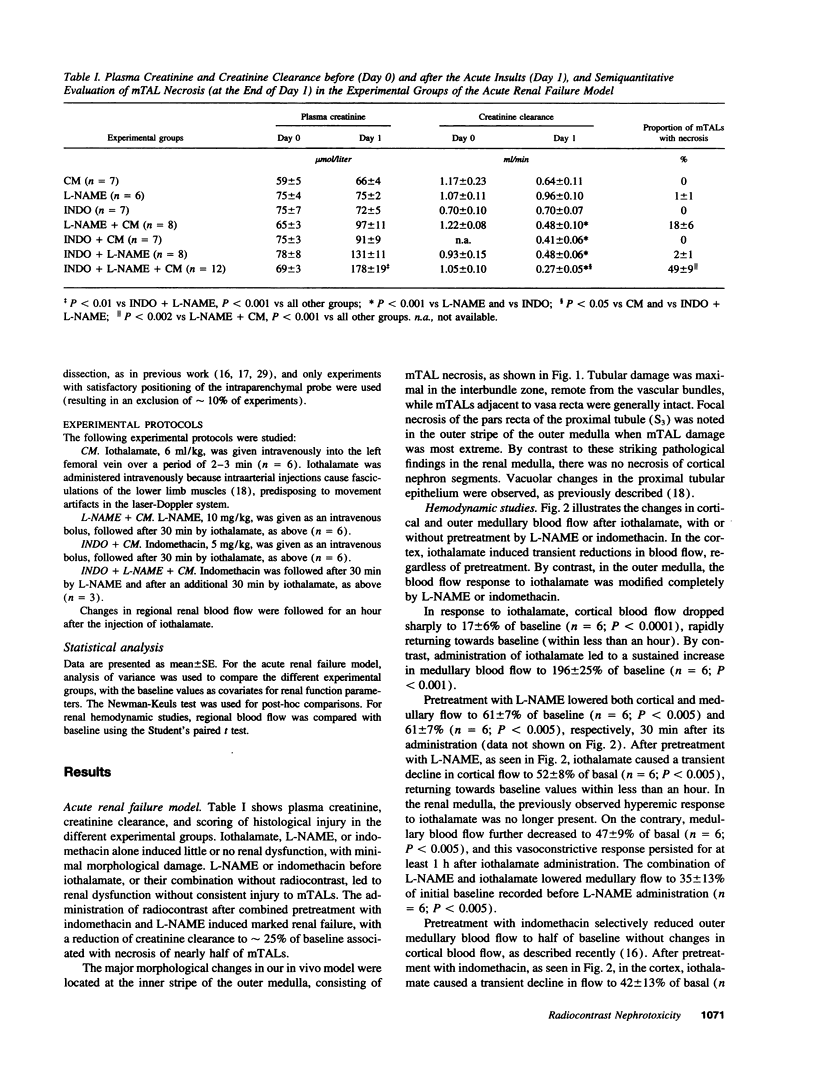
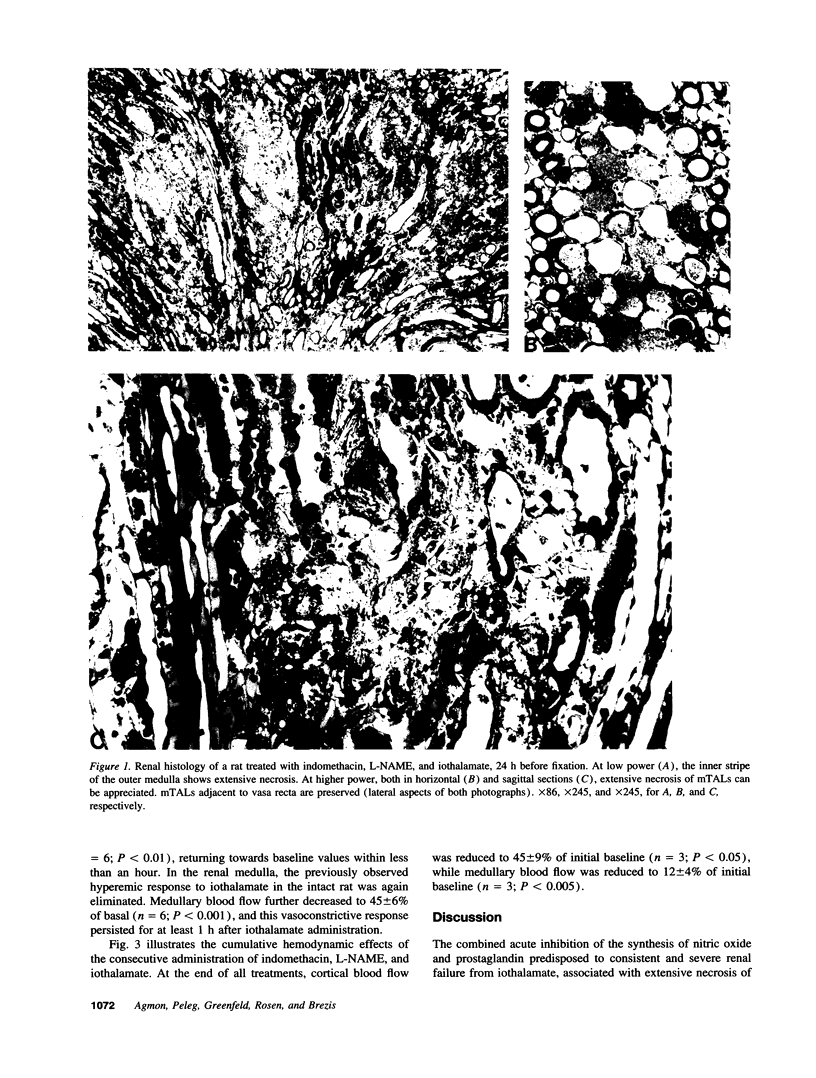
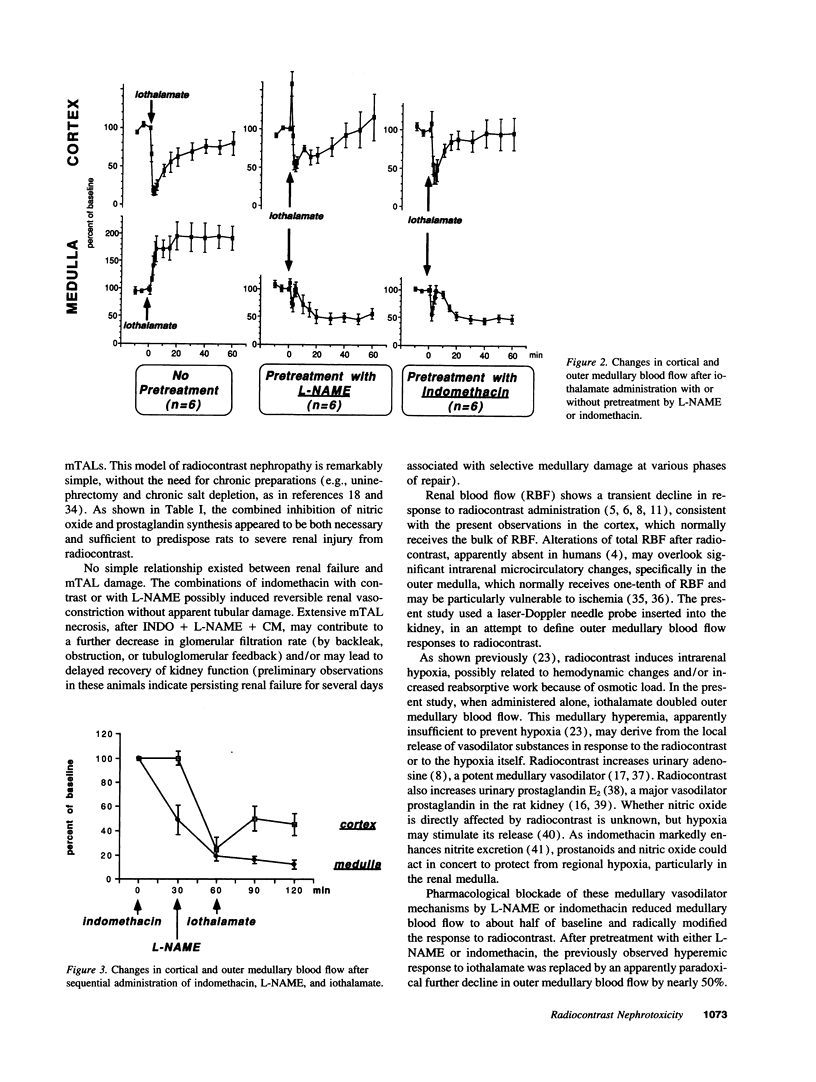
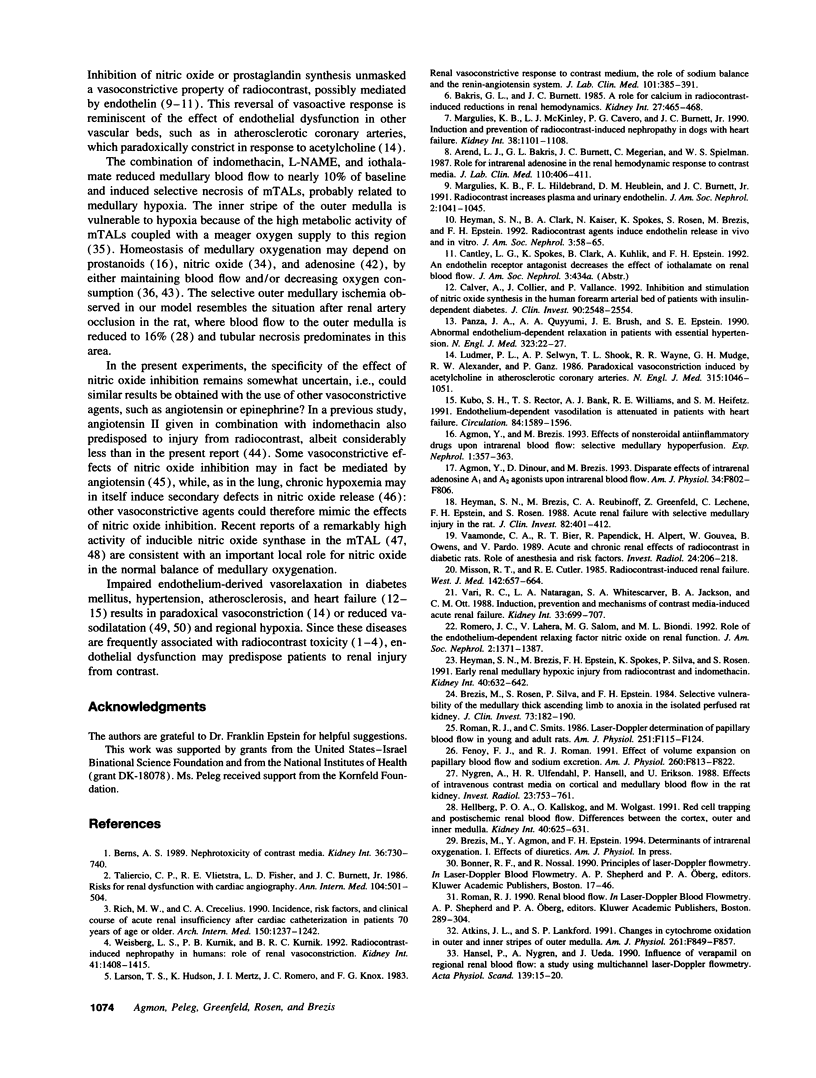
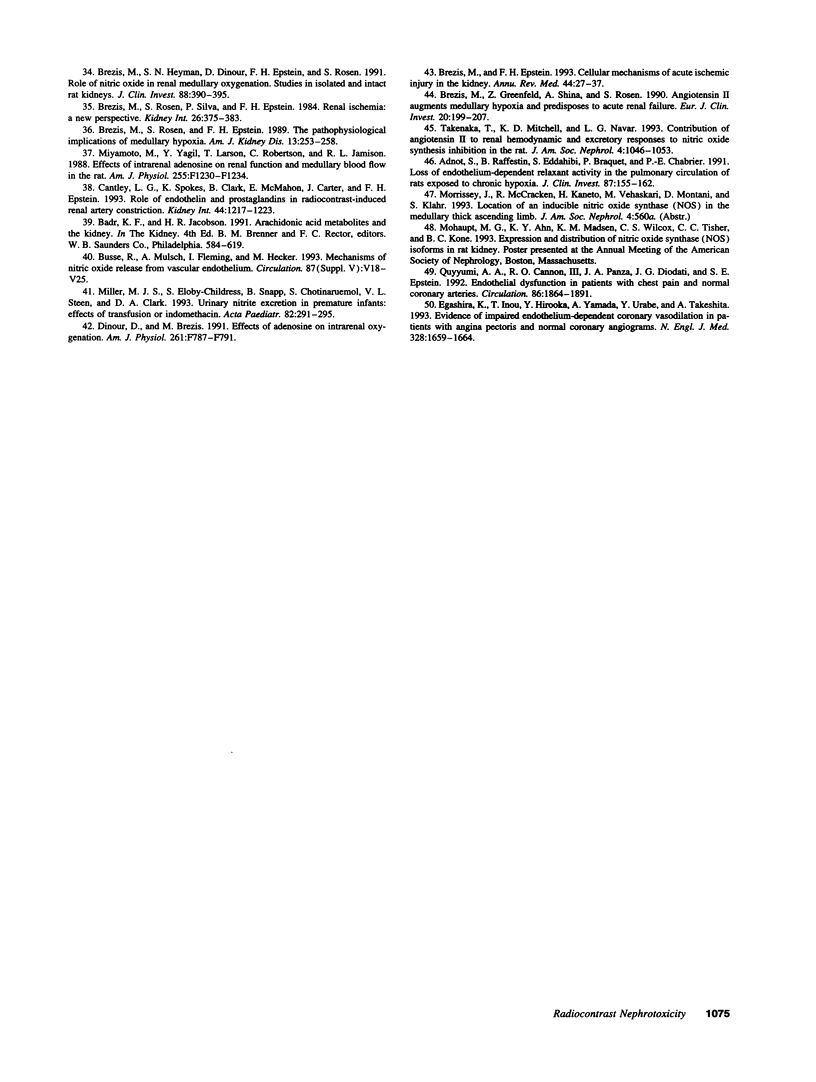
Images in this article
Selected References
These references are in PubMed. This may not be the complete list of references from this article.
- Adnot S., Raffestin B., Eddahibi S., Braquet P., Chabrier P. E. Loss of endothelium-dependent relaxant activity in the pulmonary circulation of rats exposed to chronic hypoxia. J Clin Invest. 1991 Jan;87(1):155–162. doi: 10.1172/JCI114965. [DOI] [PMC free article] [PubMed] [Google Scholar]
- Agmon Y., Brezis M. Effects of nonsteroidal anti-inflammatory drugs upon intrarenal blood flow: selective medullary hypoperfusion. Exp Nephrol. 1993 Nov-Dec;1(6):357–363. [PubMed] [Google Scholar]
- Agmon Y., Dinour D., Brezis M. Disparate effects of adenosine A1- and A2-receptor agonists on intrarenal blood flow. Am J Physiol. 1993 Dec;265(6 Pt 2):F802–F806. doi: 10.1152/ajprenal.1993.265.6.F802. [DOI] [PubMed] [Google Scholar]
- Arend L. J., Bakris G. L., Burnett J. C., Jr, Megerian C., Spielman W. S. Role for intrarenal adenosine in the renal hemodynamic response to contrast media. J Lab Clin Med. 1987 Oct;110(4):406–411. [PubMed] [Google Scholar]
- Atkins J. L., Lankford S. P. Changes in cytochrome oxidation in outer and inner stripes of outer medulla. Am J Physiol. 1991 Nov;261(5 Pt 2):F849–F857. doi: 10.1152/ajprenal.1991.261.5.F849. [DOI] [PubMed] [Google Scholar]
- Bakris G. L., Burnett J. C., Jr A role for calcium in radiocontrast-induced reductions in renal hemodynamics. Kidney Int. 1985 Feb;27(2):465–468. doi: 10.1038/ki.1985.32. [DOI] [PubMed] [Google Scholar]
- Berns A. S. Nephrotoxicity of contrast media. Kidney Int. 1989 Oct;36(4):730–740. doi: 10.1038/ki.1989.254. [DOI] [PubMed] [Google Scholar]
- Brezis M., Epstein F. H. Cellular mechanisms of acute ischemic injury in the kidney. Annu Rev Med. 1993;44:27–37. doi: 10.1146/annurev.me.44.020193.000331. [DOI] [PubMed] [Google Scholar]
- Brezis M., Greenfeld Z., Shina A., Rosen S. Angiotensin II augments medullary hypoxia and predisposes to acute renal failure. Eur J Clin Invest. 1990 Apr;20(2):199–207. doi: 10.1111/j.1365-2362.1990.tb02269.x. [DOI] [PubMed] [Google Scholar]
- Brezis M., Heyman S. N., Dinour D., Epstein F. H., Rosen S. Role of nitric oxide in renal medullary oxygenation. Studies in isolated and intact rat kidneys. J Clin Invest. 1991 Aug;88(2):390–395. doi: 10.1172/JCI115316. [DOI] [PMC free article] [PubMed] [Google Scholar]
- Brezis M., Rosen S. N., Epstein F. H. The pathophysiological implications of medullary hypoxia. Am J Kidney Dis. 1989 Mar;13(3):253–258. doi: 10.1016/s0272-6386(89)80062-9. [DOI] [PubMed] [Google Scholar]
- Brezis M., Rosen S., Silva P., Epstein F. H. Renal ischemia: a new perspective. Kidney Int. 1984 Oct;26(4):375–383. doi: 10.1038/ki.1984.185. [DOI] [PubMed] [Google Scholar]
- Brezis M., Rosen S., Silva P., Epstein F. H. Selective vulnerability of the medullary thick ascending limb to anoxia in the isolated perfused rat kidney. J Clin Invest. 1984 Jan;73(1):182–190. doi: 10.1172/JCI111189. [DOI] [PMC free article] [PubMed] [Google Scholar]
- Calver A., Collier J., Vallance P. Inhibition and stimulation of nitric oxide synthesis in the human forearm arterial bed of patients with insulin-dependent diabetes. J Clin Invest. 1992 Dec;90(6):2548–2554. doi: 10.1172/JCI116149. [DOI] [PMC free article] [PubMed] [Google Scholar]
- Cantley L. G., Spokes K., Clark B., McMahon E. G., Carter J., Epstein F. H. Role of endothelin and prostaglandins in radiocontrast-induced renal artery constriction. Kidney Int. 1993 Dec;44(6):1217–1223. doi: 10.1038/ki.1993.371. [DOI] [PubMed] [Google Scholar]
- Dinour D., Brezis M. Effects of adenosine on intrarenal oxygenation. Am J Physiol. 1991 Nov;261(5 Pt 2):F787–F791. doi: 10.1152/ajprenal.1991.261.5.F787. [DOI] [PubMed] [Google Scholar]
- Egashira K., Inou T., Hirooka Y., Yamada A., Urabe Y., Takeshita A. Evidence of impaired endothelium-dependent coronary vasodilatation in patients with angina pectoris and normal coronary angiograms. N Engl J Med. 1993 Jun 10;328(23):1659–1664. doi: 10.1056/NEJM199306103282302. [DOI] [PubMed] [Google Scholar]
- Fenoy F. J., Roman R. J. Effect of volume expansion on papillary blood flow and sodium excretion. Am J Physiol. 1991 Jun;260(6 Pt 2):F813–F822. doi: 10.1152/ajprenal.1991.260.6.F813. [DOI] [PubMed] [Google Scholar]
- Hansell P., Nygren A., Ueda J. Influence of verapamil on regional renal blood flow: a study using multichannel laser-Doppler flowmetry. Acta Physiol Scand. 1990 May;139(1):15–20. doi: 10.1111/j.1748-1716.1990.tb08892.x. [DOI] [PubMed] [Google Scholar]
- Heyman S. N., Brezis M., Epstein F. H., Spokes K., Silva P., Rosen S. Early renal medullary hypoxic injury from radiocontrast and indomethacin. Kidney Int. 1991 Oct;40(4):632–642. doi: 10.1038/ki.1991.255. [DOI] [PubMed] [Google Scholar]
- Heyman S. N., Brezis M., Reubinoff C. A., Greenfeld Z., Lechene C., Epstein F. H., Rosen S. Acute renal failure with selective medullary injury in the rat. J Clin Invest. 1988 Aug;82(2):401–412. doi: 10.1172/JCI113612. [DOI] [PMC free article] [PubMed] [Google Scholar]
- Heyman S. N., Clark B. A., Kaiser N., Spokes K., Rosen S., Brezis M., Epstein F. H. Radiocontrast agents induce endothelin release in vivo and in vitro. J Am Soc Nephrol. 1992 Jul;3(1):58–65. doi: 10.1681/ASN.V3158. [DOI] [PubMed] [Google Scholar]
- Kubo S. H., Rector T. S., Bank A. J., Williams R. E., Heifetz S. M. Endothelium-dependent vasodilation is attenuated in patients with heart failure. Circulation. 1991 Oct;84(4):1589–1596. doi: 10.1161/01.cir.84.4.1589. [DOI] [PubMed] [Google Scholar]
- Larson T. S., Hudson K., Mertz J. I., Romero J. C., Knox F. G. Renal vasoconstrictive response to contrast medium. The role of sodium balance and the renin-angiotensin system. J Lab Clin Med. 1983 Mar;101(3):385–391. [PubMed] [Google Scholar]
- Ludmer P. L., Selwyn A. P., Shook T. L., Wayne R. R., Mudge G. H., Alexander R. W., Ganz P. Paradoxical vasoconstriction induced by acetylcholine in atherosclerotic coronary arteries. N Engl J Med. 1986 Oct 23;315(17):1046–1051. doi: 10.1056/NEJM198610233151702. [DOI] [PubMed] [Google Scholar]
- Margulies K. B., Hildebrand F. L., Heublein D. M., Burnett J. C., Jr Radiocontrast increases plasma and urinary endothelin. J Am Soc Nephrol. 1991 Nov;2(5):1041–1045. doi: 10.1681/ASN.V251041. [DOI] [PubMed] [Google Scholar]
- Margulies K. B., McKinley L. J., Cavero P. G., Burnett J. C., Jr Induction and prevention of radiocontrast-induced nephropathy in dogs with heart failure. Kidney Int. 1990 Dec;38(6):1101–1108. doi: 10.1038/ki.1990.319. [DOI] [PubMed] [Google Scholar]
- Miller M. J., Eloby-Childress S., Snapp B., Chotinaruemol S., Steen V. L., Clark D. A. Urinary nitrite excretion in premature infants: effects of transfusion or indomethacin. Acta Paediatr. 1993 Mar;82(3):291–295. doi: 10.1111/j.1651-2227.1993.tb12662.x. [DOI] [PubMed] [Google Scholar]
- Misson R. T., Cutler R. E. Radiocontrast-induced renal failure. West J Med. 1985 May;142(5):657–664. [PMC free article] [PubMed] [Google Scholar]
- Miyamoto M., Yagil Y., Larson T., Robertson C., Jamison R. L. Effects of intrarenal adenosine on renal function and medullary blood flow in the rat. Am J Physiol. 1988 Dec;255(6 Pt 2):F1230–F1234. doi: 10.1152/ajprenal.1988.255.6.F1230. [DOI] [PubMed] [Google Scholar]
- Nygren A., Ulfendahl H. R., Hansell P., Erikson U. Effects of intravenous contrast media on cortical and medullary blood flow in the rat kidney. Invest Radiol. 1988 Oct;23(10):753–761. doi: 10.1097/00004424-198810000-00010. [DOI] [PubMed] [Google Scholar]
- Olof P., Hellberg A., Källskog O., Wolgast M. Red cell trapping and postischemic renal blood flow. Differences between the cortex, outer and inner medulla. Kidney Int. 1991 Oct;40(4):625–631. doi: 10.1038/ki.1991.254. [DOI] [PubMed] [Google Scholar]
- Panza J. A., Quyyumi A. A., Brush J. E., Jr, Epstein S. E. Abnormal endothelium-dependent vascular relaxation in patients with essential hypertension. N Engl J Med. 1990 Jul 5;323(1):22–27. doi: 10.1056/NEJM199007053230105. [DOI] [PubMed] [Google Scholar]
- Quyyumi A. A., Cannon R. O., 3rd, Panza J. A., Diodati J. G., Epstein S. E. Endothelial dysfunction in patients with chest pain and normal coronary arteries. Circulation. 1992 Dec;86(6):1864–1871. doi: 10.1161/01.cir.86.6.1864. [DOI] [PubMed] [Google Scholar]
- Rich M. W., Crecelius C. A. Incidence, risk factors, and clinical course of acute renal insufficiency after cardiac catheterization in patients 70 years of age or older. A prospective study. Arch Intern Med. 1990 Jun;150(6):1237–1242. [PubMed] [Google Scholar]
- Roman R. J., Smits C. Laser-Doppler determination of papillary blood flow in young and adult rats. Am J Physiol. 1986 Jul;251(1 Pt 2):F115–F124. doi: 10.1152/ajprenal.1986.251.1.F115. [DOI] [PubMed] [Google Scholar]
- Romero J. C., Lahera V., Salom M. G., Biondi M. L. Role of the endothelium-dependent relaxing factor nitric oxide on renal function. J Am Soc Nephrol. 1992 Mar;2(9):1371–1387. doi: 10.1681/ASN.V291371. [DOI] [PubMed] [Google Scholar]
- Takenaka T., Mitchell K. D., Navar L. G. Contribution of angiotensin II to renal hemodynamic and excretory responses to nitric oxide synthesis inhibition in the rat. J Am Soc Nephrol. 1993 Oct;4(4):1046–1053. doi: 10.1681/ASN.V441046. [DOI] [PubMed] [Google Scholar]
- Taliercio C. P., Vlietstra R. E., Fisher L. D., Burnett J. C. Risks for renal dysfunction with cardiac angiography. Ann Intern Med. 1986 Apr;104(4):501–504. doi: 10.7326/0003-4819-104-4-501. [DOI] [PubMed] [Google Scholar]
- Vaamonde C. A., Bier R. T., Papendick R., Alpert H., Gouvea W., Owens B., Pardo V. Acute and chronic renal effects of radiocontrast in diabetic rats. Role of anesthesia and risk factors. Invest Radiol. 1989 Mar;24(3):206–218. doi: 10.1097/00004424-198903000-00006. [DOI] [PubMed] [Google Scholar]
- Vari R. C., Natarajan L. A., Whitescarver S. A., Jackson B. A., Ott C. E. Induction, prevention and mechanisms of contrast media-induced acute renal failure. Kidney Int. 1988 Mar;33(3):699–707. doi: 10.1038/ki.1988.55. [DOI] [PubMed] [Google Scholar]
- Weisberg L. S., Kurnik P. B., Kurnik B. R. Radiocontrast-induced nephropathy in humans: role of renal vasoconstriction. Kidney Int. 1992 May;41(5):1408–1415. doi: 10.1038/ki.1992.206. [DOI] [PubMed] [Google Scholar]




